History of the Meiji Gakuin Collections: valuable books and background to the collections
- 1. Books donated when Tokyo Itchi Shin-Gakko (Tokyo Union Theological Seminary) opened
- 2. Books owned by Tsukiji Dai-Gakko
- 3. Books owned by Tsukiji Hospital
- 4. Books owned by Tokyo Itchi Eiwa-Gakko
- 5. Books from the early days of Meiji Gakuin
- 6. Books owned by Tozan Gakuin “Steel Academy”
- 7. Books formerly owned by the Yokohama United Club (YUC)
- 8. Books donated by those related to Presbyterian missions during the immediate post-WWⅡ years
- 9. Books from the United States (US) military forces
- 10. Books gathered during the activities of Meiji Gakuin
1. Books donated when Tokyo Itchi Shin-Gakko (Tokyo Union Theological Seminary) opened
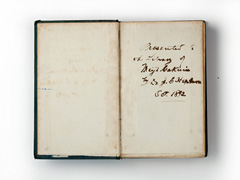
Hepburn’s signature in the books
he donated.
In June 1877, three missions (the Presbyterian Church in the United States of America, United Presbyterian Church of Scotland, and Dutch Reformed Church in America) held a joint committee and decided on a plan to establish “Tokyo Itchi Shin-Gakko.” Following this decision, a great number of books were donated from Scotland, Britain, and the United States of America. These books include a written note, which includes the donor’s names, stating that the book was “Presented to the Union Theological School.” In addition, there are books on Japan owned by Dr. Hepburn. However, these books were already valuable back then, and therefore include a written note saying “Loaned to.”

Hepburn’s signature in the books
he donated.
2. Books owned by Tsukiji Dai-Gakko
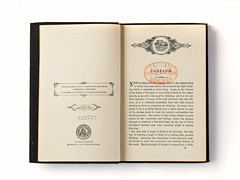
Ownership stamp
“Tsukiji Dai-Gakko”
Tsukiji Dai-Gakko was a liberal arts school for English studies. A monument is built to mark the birthplace of Meiji Gakuin at the site where the 6th building of the Tsukiji enclave once stood.

Ownership stamp
“Tsukiji Dai-Gakko”
3. Books owned by Tsukiji Hospital
These books were owned by Tsukiji Hospital (1874-1886) run by Tokyo Union Church, which was located across the street from Tsukiji Dai-Gakko (currently St Luke’s Garden Tower). Dr. Henry Faulds, famous for discovering and developing fingerprints and fingerprinting, was the superintendent of the hospital. He also taught as a professor at Tsukiji Dai-Gakko and Tokyo Itchi Eiwa-Gakko (United Japanese-English Union School). Faulds is also known for creating the first textbook for the visually impaired in Japan together with Ginko Kishida and others. The National Police Agency has built a monument to mark the “birthplace of fingerprint studies” at the site where Tsukiji Hospital used to be.
4. Books owned by Tokyo Itchi Eiwa-Gakko
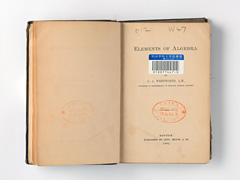
Ownership stamp
“Tokyo Itchi Eiwa-Gakko”
These books were owned by the college, which was the result of the merging of Tsukiji Dai-Gakko and the Senshi Gakko in Yokohama, which was managed by the Dutch Reformed Church in America.

Ownership stamp
“Tokyo Itchi Eiwa-Gakko”
5. Books from the early days of Meiji Gakuin
These books were donated by or bought from Britain and the United States in the middle of the Meiji period, when Meiji Gakuin was established by the merger of the schools. They are primarily foreign books, although some are Japanese. There are also books donated by Dr. Hepburn.
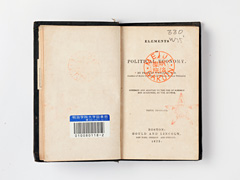
Ownership stamp “Meiji Gakuin” |
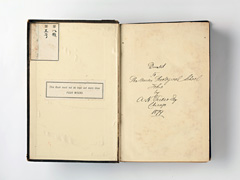
Hepburn’s signature |
6. Books owned by Tozan Gakuin “Steel Academy”
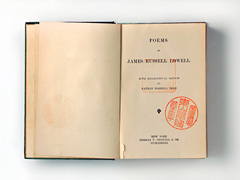
“Tozan Gakuin” “Steel Academy”
Ownership stamp
Tozan Gakuin, a reformed mission school in Nagasaki, became Meiji Gakuin Dai-ni Chugaku-bu (second junior high school) in 1932. Later, it was integrated into Meiji Gakuin. These books were housed in the library of this school.

“Tozan Gakuin” “Steel Academy”
Ownership stamp
7. Books formerly owned by the Yokohama United Club (YUC)

“YUC” Ownership stamp
The Yokohama United Club was a social club with its own library located in the Yokohama enclave. It began as a joint service club in 1863 and was expanded in 1873, playing a prominent role in the enclave. The books are marked with the ownership stamp comprising the letters YUC combined. Although not listed in the catalog, a number of books are housed by Meiji Gakuin.

“YUC” Ownership stamp
8. Books donated by those related to Presbyterian missions during the immediate post-WWⅡ years
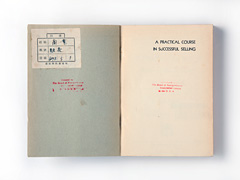
Donation stamp
Mr. and Mrs. Hannaford were assigned as missionaries in 1946. These books were gathered and donated by people in the United States around that time for the re-establishment of Meiji Gakuin.

Donation stamp
9. Books from the United States (US) military forces
To prepare for the country’s upcoming occupation of Japan, the United States began research on Japan at Harvard University and other places as soon as the Pacific War broke out by printing large numbers of American versions of various Japanese language dictionaries, Kanwa (Chinese character) dictionaries, English-Japanese dictionaries, and Japanese-English dictionaries. The United States also proceeded with cultural studies such as The Chrysanthemum and the Sword: Patterns of Japanese Culture. Meiji Gakuin University owns a portion of these dictionaries and a portion of literary works brought in by US military forces during the occupation.
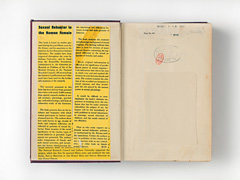
“US military forces” stamp |
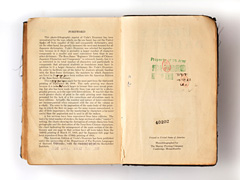
“US special forces” stamp |

Introduction of
|
10. Books gathered during the activities of Meiji Gakuin
Other than the special materials listed above, there are also materials that have accumulated in the library of Meiji Gakuin consequent to regular research and education activities. These sometimes go through changes in keeping with advancing time.
Some of these books went beyond research objectives to become the cultural property of society, and others went beyond the original intention of ownership across the ages with various factors complexly intertwined and came to form important themes relevant to the times.
With 150 years of history, Meiji Gakuin contributed its English skills during the establishment of modern Japan, thus making a significant mark. The predecessors’ efforts in the fields of dictionaries, conversation books, Bibles, Christian books, social activities, and literature were reorganized for the establishment of the university’s distinctive collections, which will continue to grow in the future.